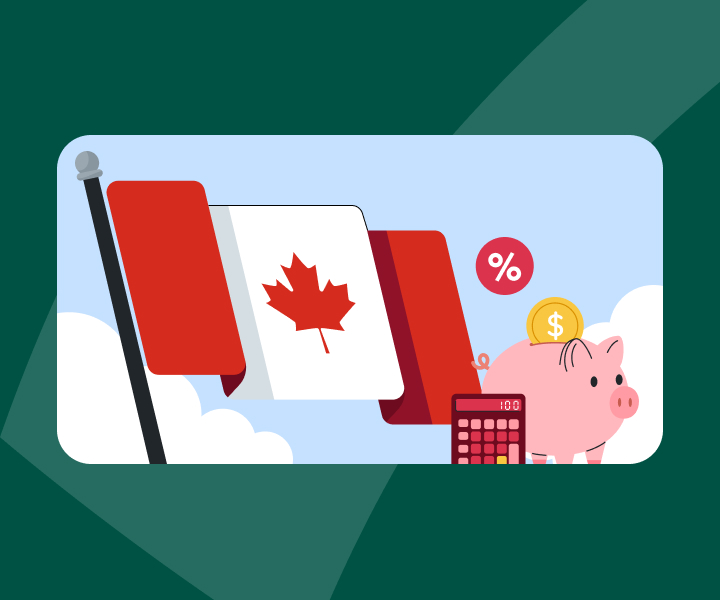Trump’s Tariffs on Canada: What You Need To Know
TurboTax Canada
July 22, 2025 | 3 Min Read
Updated for tax year 2024

U.S. President Donald Trump stunned Canadians once again in July 2025 by announcing a dramatic increase in tariffs on goods effective August, 2025. While Prime Minister Mark Carney has been working for months behind the scenes to secure a trade deal, the Trump administration issued an open letter to Canada announcing the tariffs. The letter states the move targets Canada’s allegedly weak fentanyl controls, high tariffs on American dairy, and the growing U.S.–Canada trade deficit.
With so much talk swirling around about tariffs, you may understandably be asking, what do tariffs have to do with me? From understanding tariffs to navigating how this affects your finances and taxes, we help you cut through the noise and tell you everything that’s important for you to know right now.
What are tariffs?
A tariff is a tax imposed by a country on goods that are imported from other countries. Like a sales tax, it’s added to the price of foreign goods at the border and charged to the person or company that is importing the goods. Governments use them to:
- Protect their own industries and sectors by raising prices on imported products from elsewhere
- Reduce trade deficits (the amount by which a country’s imports exceed the value of its exports) by making imports pricier
- Leverage in negotiations, as an incentive for countries to come to the table and negotiate deals
The proposed Trump‑led tariffs apply broadly to goods that don’t have exemptions in the current trade deal known in Canada as the Canada-United States-Mexico Agreement (CUSMA) including metals, autos, energy products, pharmaceuticals, and more.
What U.S. tariffs does Canada already face?
After taking over the U.S. presidency, Trump originally announced a 25 percent tariff on all Canadian goods and a 10 percent tariff on Canadian energy resources, earlier this year, citing the need for stronger fentanyl control at the border.
Those tariffs were paused for 30 days following assurances from Canada that our government would take appropriate action to curb the flow of fentanyl from Canada to the U.S. The tariffs were then reimposed in early March. They are now rising again, to 35 percent.
Canada, the biggest foreign supplier of steel and aluminium to the U.S., was hit by Trump’s separate 25 percent tariffs on steel and aluminium, which he imposed globally in the spring. Trump doubled that in June, saying the measure would protect and bolster the U.S. metals sector. Trump also announced a separate tariff on imported cars and car parts.
Until the start of Trump’s second term as U.S. president in January this year, Canada had enjoyed years of free trade relations with the U.S. with the CUSMA agreement which was negotiated and enacted during Trump’s first term.
How will Canadians be affected by tariffs?
Everyday Canadians
- Higher prices for many goods at the store: Think groceries, electronics, car parts—many imports could cost an extra 10–35%. Even US‑made goods that use Canadian steel or parts might see price increases.
- More expensive car maintenance: Auto components not covered by the USMCA could cost significantly more due to a new 35% duty.
- Energy bills impacted: A 10% tariff on non‑USMCA energy could affect costs for oil, gas, and fertilizer.
- Employers may find themselves downsizing: With rising costs and less profit, some employers in hard-hit sectors may be laying off workers.
Canadian business owners
Small and medium-sized businesses that rely on U.S. imports or export goods to the U.S. face increased complexity:
- Increased costs: Supply chain disruptions, higher import duties, and unpredictable pricing may squeeze company profits and mean restructuring.
- Export uncertainty: Canada may impose “retaliatory tariffs”, and those can reduce U.S. demand for Canadian products and reduce cross-border sales. But it can also mean that businesses prefer to buy Canadian goods.
- Import cost chaos: Business owners should use tools like the Canada Tariff Finder and Harmonized System classification to track new duties and compliance.
Tax and financial implications of tariffs
For employees & consumers
Higher prices from tariffs may impact your disposable income. When filing your taxes:
- Use RRSPs and TFSA contributions wisely to offset living cost rises. Money withdrawn from RRSPs will have tax consequences, while withdrawing funds from a TFSA is tax-free.
- Claim home office or vehicle expenses accurately, especially if remote work saves commuting costs. Ensure that your employer signs a T2200 - Declaration of Conditions of Employment.
- Watch for new provincial programs and benefits providing relief, rebates and job training.
- Given that interest rates are finally lowering, this may be the time to revisit any loans or mortgages to potentially save money on borrowing costs.
For small business owners
Some additional considerations for business owners when filing their taxes:
- Tariffs paid by a Canadian company on goods imported should be included in the costs of goods sold and taken as a deduction.
- Tariffs are added to goods before the GST/HST is calculated. Businesses can claim the GST/HST on those goods and the cost of tariffs through Input Tax Credits
Planning Ahead
Here are some things that may help you to navigate this volatile time:
- Seek professional advice: Tax experts and trade advisors can help optimize deductions and manage tariff-impact strategies.
- Manage your budget: Adjust your household and business finances for likely price increases.
- Think long-term: Understand that tariffs are moving targets right now—they may ease or escalate depending on negotiation outcomes leading up to the CUSMA review that is scheduled for 2026.
While the new 35% U.S. tariff on Canadian exports takes effect August 1, 2025, not all goods are impacted—those included in the current CUSMA agreement remain tariff‑free. However, everyday Canadians and small businesses should prepare for potential cost increases, supply‑chain adjustments, and shifting tax landscapes.
TurboTax Canada knows taxes and is here to help. Whether it’s new benefits, navigating Input Tax Credits, or claiming every deduction, we simplify filing—so you can focus on staying agile amid an evolving trade and tax environment.
Get Started
Related articles

© 1997-2024 Intuit, Inc. All rights reserved. Intuit, QuickBooks, QB, TurboTax, Profile, and Mint are registered trademarks of Intuit Inc. Terms and conditions, features, support, pricing, and service options subject to change without notice.
Copyright © Intuit Canada ULC, 2024. All rights reserved.
The views expressed on this site are intended to provide generalized financial information designed to educate a broad segment of the public; it does not give personalized tax, investment, legal, or other business and professional advice. Before taking any action, you should always seek the assistance of a professional who knows your particular situation for advice on taxes, your investments, the law, or any other business and professional matters that affect you and/or your business.









